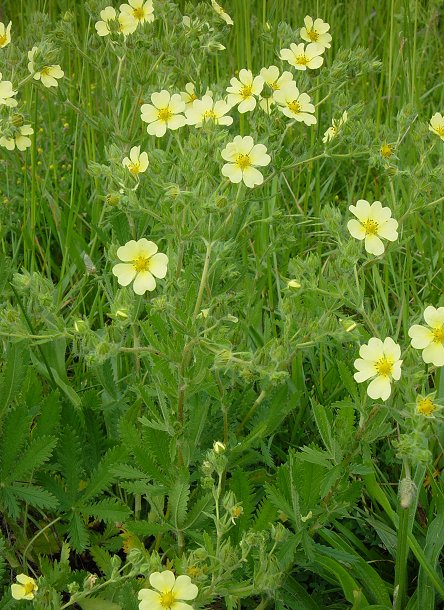Potentilla recta L.
Rough-Fruited Cinquefoil

Introduced
CC = *
CW = 5
MOC = 82
© DETenaglia
Potentilla recta L.Rough-Fruited Cinquefoil | |
 |
Introduced CC = * CW = 5 MOC = 82 |
© DETenaglia |
|
Family - Rosaceae Habit - Rhizomatous perennial forb. Stems - Ascending to erect, to 80 cm, branching, moderately to densely pubescent (more densely so toward the tip) with longer and shorter, appressed and spreading hairs, the shorter hairs usually gland-tipped, the longer hairs often with minute, pustular bases.
Leaves - Alternate, petiolate to sessile, palmately compound, stipulate. Petioles 3-8 cm long, these densely hairy with glandular and nonglandular hairs. Stipules 8-30 mm long, lanceolate to ovate, with several deep, slender lobes, these sharply pointed at the tip, hairy. Leaf blades 3-10 cm long, palmately compound with 5 or 7 leaflets, these 1.5-10 cm long, sessile, narrowly oblanceolate to oblanceolate, rounded to bluntly pointed at the tips, the margins coarsely toothed, the upper surface green, glabrous or sparsely to moderately hairy, the undersurface lighter green, moderately hairy, especially along the veins.
Inflorescence - Terminal, relatively open, flat-topped to shallowly dome-shaped panicles of several flowers. Pedicels pilose to hirsute, often subtended by reduced foliaceous bracts.
Flowers - Bractlets 5-12 mm long, narrowly lanceolate to lanceolate, moderately hairy. Hypanthia 5-9 mm in diameter, cup-shaped. Sepals 5, 4-10 mm long, oblanceolate to elliptic, sharply pointed at the tips. Petals 5, 4-13 mm long, more or less heart-shaped to broadly obovate with a shallowly and broadly notched tip, pale yellow to lemon yellow. Stamens 25-30. Filaments filiform, to 4 mm long. Anthers yellow, 1.8 mm long. Ovaries with the styles attached near the tips.
Fruits - Achenes 1.2-1.8 mm long, the surface usually coarsely wrinkled, brown, unwinged, densely aggregated on the surface of the receptacle. Flowering - May - August. Habitat - Prairies, bases and tops of bluffs, glades, streambanks, pastures, fields, railroads, roadsides, and open, disturbed areas. Origin - Native to Europe. Other info. - This species is a common roadside plant throughout all of Missouri. It also occurs across the continental U.S., though is uncommon in the central Plains and many southern regions. It is considered a noxious weed in portions of the Northwest. In Missouri it seems relatively well behaved. The plant is easily identified by its largish, pale yellow flowers and distinctive leaves. The anthers typically bear a central dark spot, which gives the entire flower a unique appearance. The flowers are the largest and palest-colored of any cinqefoil in the state. If left untouched the plant can form large stands, as shown above. The flowers are quite showy and the species is suitable for a low maintenance garden. Care should be taken not to spread the plant in the wild as it is introduced. Photographs taken somewhere in NC., 5-16-03 (DETenaglia); also at Grand Trace Conservation Area, Harrison County, MO, 6-13-2014; Weldon Spring Conservation Area, St. Charles County, MO, 5-31-2020, and at Illiniwek Village State Historic Site, Clark County, MO, 7-10-2023 (SRTurner). |